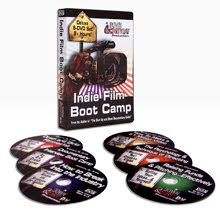
There is this great part of Jerry Seinfeld's "I'm Telling You For The Last Time" standup set where he talks about warning labels and comments that the ONLY label warning that humans consistently pay attention to is "Dry Clean Only".
Low budget and guerrilla filmmaking is inherently risky. You are making due without the top notch tools of the trade and going around a lot of hoops instead of jumping through them. And it is fun sometimes. It is thrilling and invigorating when everyone on set is willing to do anything to "get the shot".
We look back at times when things go wrong on set and often laugh. You feel the adrenalin pump when the dare devil Dp is on his tiptoes on the top of a ladder, you have actors do their own stunts, you tell war stories of the time that lamp caught fire. "Danger" is our collective middle name.
It is all fun and games until someone gets so hurt they die, and then it is dead silent.
A long and Enquire-esque article came out in the Village Voice two weeks ago about a tragic accident on an NYU shoot last year where a young man died electrocuted. The event was horrible, it should never have happened. The article, though, is tainted with a taste-less flair for the dramatic.
Callously titled "NYU's Snuff Film", the article goes into details
 about the different events that lead to the electrucution, and the aftermath it has had on NYU students and on the crew that was there that day. Having been on set that set in Georgia myself, and having been a friend of John (the young man who passed away), I am disturbed by the article not just because it brings back haunting memories, but because of glaring omissions, pointing of fingers and the style in which it was written.
about the different events that lead to the electrucution, and the aftermath it has had on NYU students and on the crew that was there that day. Having been on set that set in Georgia myself, and having been a friend of John (the young man who passed away), I am disturbed by the article not just because it brings back haunting memories, but because of glaring omissions, pointing of fingers and the style in which it was written.REGARDLESS of that, I am still writing this entry and telling people about the article because if any good comes of it it is that people are aware of what the worst that can happen really is. This particular event was the result of a butterfly effect-like chain reaction with no one single causing factor. So you never know what weak link is going to bring the whole production down. The best you can do is prevent.
A student is quoted in the damned Voice article:
"I look at every future project in a different way now. I fully understand the risk I take, and the risk I assign to those who work with me and to those who follow my directions. Safety, and making sure we don't try to 'get away with it,' is a much bigger deal. If I see something dumb happening, I'm going to stop it right away. If 'getting the shot' or 'making the day' is going to involve an inordinate amount of risk, it's no longer a good idea the way it used to be."
Read the instructions. Spend the extra money on safety precautions and insurance. Get pro's to do a pro's job. If you are a fan of Down & Dirty, check out the safety measures described in the Shut Up & Shoot Documentary Guide. It just really is better to be safe than sorry.














